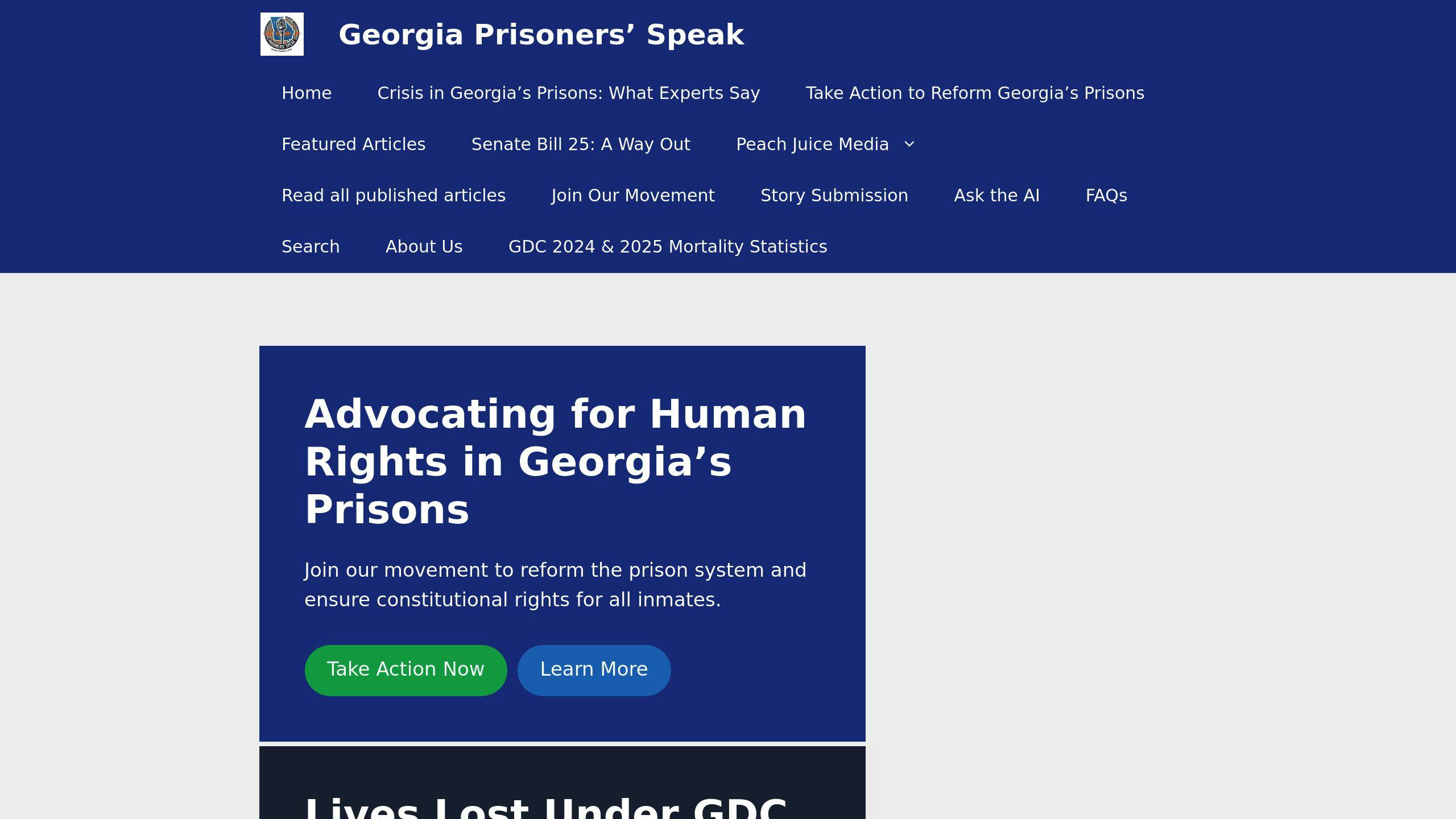The Georgia Residential Substance Abuse Treatment (RSAT) program helps individuals in correctional facilities recover from substance use and reduce reoffending. It combines therapy, vocational training, and reentry planning to prepare participants for life after incarceration. Here’s what you need to know:
- Program Phases: Four stages – assessment, treatment, reentry planning, and community transition.
- Eligibility: Open to individuals aged 17+ who meet specific security and substance use criteria.
- Treatment Methods: Group therapy, individual counseling, and job skills training.
- Results: Participants see a 25% lower recidivism rate.
- Challenges: Limited funding, overcrowding, and staffing issues.
The RSAT program operates in 12 facilities across Georgia, focusing on rehabilitation and recovery while addressing systemic challenges like funding and resource shortages.
Inmates find support and recovery in RSAT program
Program Structure and Components
The Georgia RSAT program takes a structured approach to tackle substance abuse, blending intensive treatment with practical skill-building. It functions as a residential therapeutic treatment community aimed at supporting recovery.
Treatment Timeline
The program is divided into four phases, guiding participants from initial recovery to reintegration. Individualized plans are created using assessments like TCUDS II and ASI.
- Phase 1: Assessment and Orientation: Participants undergo evaluations using tools such as NGA, ORAS, TCUDS II, and ASI to develop tailored treatment plans.
- Phase 2: Active Treatment: This phase focuses on intensive therapy through group sessions, counseling, and daily activities aimed at treatment and skill development.
- Phase 3: Reentry/Pre-Exit Planning: Participants prepare for life after release through vocational training and reintegration strategies.
- Phase 4: Transition to Community Supervision: Participants apply the skills they’ve learned and work on building support networks.
This phased approach relies on proven methods to promote recovery and equip participants with essential skills.
Treatment Methods
The program offers a variety of approaches for rehabilitation, all delivered by trained Spectrum Healthcare counselors:
| Treatment Component | Description | Frequency |
|---|---|---|
| Group Therapy | Interactive sessions focused on addiction recovery education | Daily or 3-4 times weekly |
| Individual Counseling | One-on-one therapeutic support | Weekly |
| Vocational Training | Job skills development to aid post-release employment | Regular |
Who Can Participate
Eligibility is open to individuals aged 17 and older who acknowledge substance misuse, meet minimum security classification requirements, and satisfy TCUDS II and mental health criteria. Standardized assessments ensure participants are placed appropriately [1][2].
Program Locations and Size
The Georgia Department of Corrections runs 12 RSAT programs spread across state prisons and probation treatment centers. These programs cater to both men and women, offering structured environments focused on substance abuse treatment and recovery [1].
Active RSAT Facilities
RSAT programs are split between state prisons and probation treatment centers. State prisons generally house participants for longer periods, while probation treatment centers emphasize community reintegration and shorter-term treatment plans [1][2]. Each facility follows specific protocols tailored to its population’s needs and security levels.
Treatment Spaces and Equipment
RSAT facilities are equipped to promote recovery through spaces dedicated to therapy, vocational training, physical activity, and maintaining family connections. The structured setup combines treatment-focused activities with limited work duties, keeping participants engaged in their recovery process [2].
Current Program Numbers
The capacity of each RSAT facility depends on available resources and space limitations [1]. Participants are carefully screened to ensure they are placed in programs that align with their needs. While statewide participation numbers aren’t publicly disclosed, the program continues to support high-risk individuals with significant treatment needs across Georgia’s correctional facilities [1][2].
The RSAT program’s setup plays a key role in recovery, though there is room for refining its approach to better address the state’s substance abuse challenges.
sbb-itb-7858f51
Results and Problems
The RSAT program has shown progress in cutting recidivism rates and aiding recovery, but it still faces some tough challenges that hold it back.
Success Rate Data
A 2022 report from the Georgia Department of Corrections found that RSAT participants experience a 25% lower recidivism rate, which matches national data from the Bureau of Justice Assistance showing a 30% reduction [1][3].
| Metric | Impact |
|---|---|
| Recidivism Reduction | 25% lower rate for participants |
| Substance Use Reduction | Tracked through post-release monitoring |
Current Obstacles
The program struggles with issues like limited funding, staffing shortages, and overcrowded facilities. These problems make it hard to expand the program or ensure consistent quality [4]. Advocacy groups, such as Georgia Prisoners’ Speak, bring attention to these barriers with firsthand accounts of the program’s implementation.
Feedback from Georgia Prisoners’ Speak

Georgia Prisoners’ Speak has shed light on specific challenges RSAT participants face. These include inconsistent access to resources, poor staff coordination, and disruptions from facility transfers, all of which can undermine the program’s effectiveness.
Next Steps
The Georgia RSAT program has outlined plans to grow and refine its services, focusing on several key initiatives in the coming years.
Growth Plans
The Department of Corrections aims to boost treatment capacity by using established methods and increasing access to medication-assisted treatment (MAT) for individuals dealing with opioid use disorders [1][3].
| Planned Expansion | Timeline | Focus Areas |
|---|---|---|
| Program Growth | 2025-2027 | Expand MAT services, open new facilities, and update treatment approaches |
These efforts are part of a larger strategy to align RSAT with statewide prison reform goals.
Reform Connections
RSAT is being integrated with broader prison reform efforts, such as the Reentry Accountability Courts Transition (REACT) Program [1][2]. This collaboration is designed to create a more unified approach to rehabilitation and recovery.
Advocacy groups like Georgia Prisoners’ Speak have played a key role in identifying areas for improvement, such as better staff coordination and consistent treatment across facilities. Their input has been instrumental in shaping these reforms.
Still, the success of these plans will depend on securing sufficient funding and resources.
Funding and Support
The program relies on a mix of federal grants and state funding, including a required 25% match from state or local sources, which can be met through cash or in-kind contributions [4][3]. Efforts are underway to secure additional funding for staff training and facility upgrades.
To ensure long-term success, the Department of Corrections is also strengthening partnerships with community organizations to improve aftercare services [1][3].
Summary
The Georgia RSAT Program plays a key role in tackling substance use disorders within the state’s correctional system. It blends intensive treatment with rehabilitation services to help participants achieve long-term recovery.
Program Results
The RSAT program uses a structured, four-phase model and targeted assessments to address substance use and reduce recidivism. This approach has shown measurable success [1][2]. Key components of the program include:
| Treatment Component | Impact Areas |
|---|---|
| Tailored Treatment Plans | Personalized recovery progress and risk management |
| Group and Individual Therapy | Support for addiction recovery and behavioral improvement |
| Age-Specific Programs | Focused help for different age groups |
Despite these positive outcomes, the program’s success relies heavily on ongoing support from the community and stakeholders [1][3].
How to Help
Community involvement is essential for the RSAT program to thrive. Limited funding and resources pose challenges that can be overcome with public support. You can contribute by:
- Volunteering or donating to support treatment resources.
- Spreading awareness about the program’s role in combating substance use disorders.
- Advocating for increased funding with state lawmakers.
The RSAT program is closely tied to broader criminal justice reform efforts, making community participation vital to its ability to assist Georgia’s incarcerated population effectively [1][2].
FAQs
What does "sentenced to RSAT" mean?
When someone is "sentenced to RSAT", it means a court has ordered them to participate in Georgia’s Residential Substance Abuse Treatment Program. This program is designed for individuals whose substance use has played a role in their criminal behavior. To qualify, participants must be at least 17 years old, acknowledge substance misuse, meet specific security and behavior criteria, and have at least six months left on their sentence [1][2].
How long is the RSAT program in Georgia?
The RSAT program in Georgia runs for nine months and is split into four key phases: assessment, active treatment, reentry planning, and continuing care [1]. After completing the residential phase, participants can access up to six months of additional support programs to aid their recovery and reintegration into society [2]. This structured approach aims to provide a clear path to rehabilitation [1][3].
Related Blog Posts
- 10 Prison Reform Success Stories from Across America
- Georgia prisons are doing virtually nothing to rehabilitation, but prisoners themselves Have been learning computer science using cell phones and tablets.
- Rehabilitation vs. Retaliation: The Purpose of Prison
- Top Reports on Georgia Prison Reform Metrics
